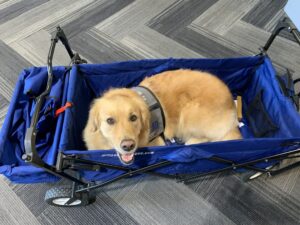
Stressors in life are a constant: do we think of them as opportunities or problems?
This past month Daisy and I completed our recertification process with Assistance Dogs International (ADI) so she can maintain her status as a service animal for another two years. Before we took the Public Access Test (PAT), Daisy and I spent three days joining the current class of dogs and handlers at Joys of Living Assistance Dogs (JLAD) in Salem, Oregon as a refresher course. It was insightful for me, being now two years into having a service animal and watching the instructors work with the new class.
A few quotes I remember hearing when I was training for the first time came to mind as I heard them again, reminding me of how overwhelmed I felt when I first took the classes two years ago. Many of the same thinking approaches are appropriate for Anxiety and Obsessive Compulsive Disorders as well.
- “Work the problem”
- While it’s easier to avoid certain situations in the short run, it can cause problems in the long run. With our dogs, we were continually told to face an issue and ‘work the problem’ rather than avoid it. So rather than avoid a trigger for a dog (a yummy treat that the dog pulls to eat or a dislike for going through a rotating door), continually practice the situation over and over until the dog – and handler – can not only achieve the goal, it no longer causes an overreaction.
- “How are you emotionally?”
- The service animals are taught to ‘read’ people: behaviorally, voice intonation, and their emotions. When a dog’s handler is anxious in a situation, the dog picks up on it and may also become uncomfortable and not perform well. Being aware of our own emotional state is important: how it affects those around us, how we approach a situation, and how we make negative assumptions about the outcome.
- “It’s not a problem, it’s an opportunity”
- Daisy consistently has had a strong prey drive and still pulls when she sees a squirrel. She is much better than before, in part because of one of the trainers would keep encouraging me to seek out squirrels and practice correct behavior (both mine and Daisy’s). Rather than see squirrels as a problem, seeing them as an opportunity to correct behavior and work as a team has changed not only my thinking about them (neutral rather than evil) but also my behavior (ignore or move towards rather than avoid) and emotions (relaxed vs tense) around them.
- “Have confidence that the dog can do it, even if you don’t feel like you can.”
- During the Public Access Test (PAT), the hardest part for many of the handlers is the three minute period where they must leave their dog for three minutes with a stranger, during which the dog is not allowed to bark, pull or look for its owner. As a handler, the inability to affect the situation can be very difficult. The trainers continually reminded us that the dogs have been training for the PAT for the past two years and they were ready. We had to trust in the dogs and their training, not how we felt about the situation.
To have Daisy assist us in the office is a true blessing, and attending class with her again helped us better hone her skillset while reminding me of the lessons that can be learned by being around skilled dog trainers; many of those lessons also apply to us too.
